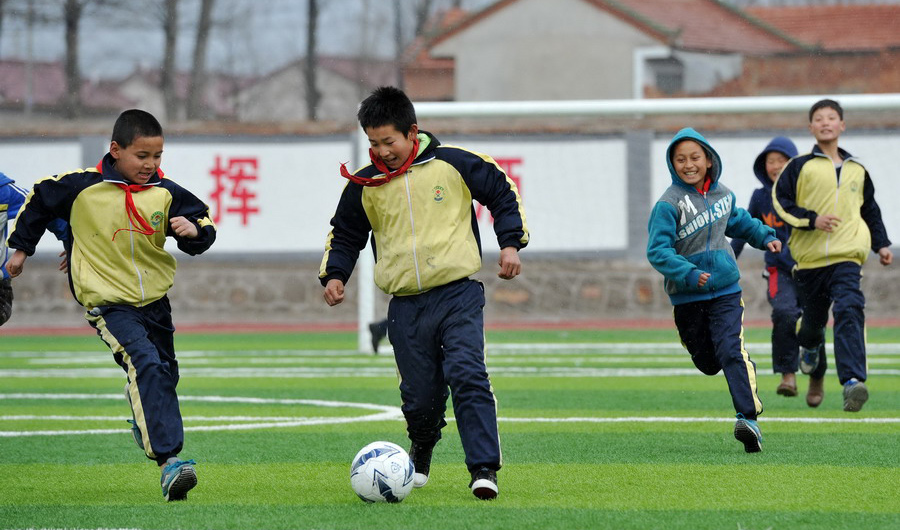Improving educational equality in rural areas

Students play football on a new field at a rural primary school in Northwest China’s Ningxia Hui Autonomous Region. In recent years, development of infrastructure and teaching tools has accelerated at rural schools to improve educational resources for students.
Education is closely linked with the development of the nation. For China, the current focus of educational development should be on rural areas, scholars said.
Jointly organized by the Chinese Society of Education and Collaborative Innovation Center of Rural Education Development in China, the third Forum on Educational Development in Rural China was held at Northeast Normal University (NNU) in Changchun, Jilin Province, from May 23 to 24.
Reviewing the development course of rural education, scholars confirmed the achievements of educational reform over the past three decades.
Wu Zhihui, dean of the Faculty of Education at NNU, said that the average years of schooling for children aged 6 and above increased from 5.20 in 1982 to 8.80 in 2010. Similarly, the scientific spirit, democratic awareness and sense of time of citizens have also made great progress.
“The content of complementary education in rural areas involved in the No.1 Central Document has changed with the improvement of rural education, from the popularization of education in 2006 to the layout in 2010 and the quality improvement in 2015. All of these changes reveal the track of rural education progress,” said Xie Weihe, vice-president of Tsinghua University.
Yang Dongping, a professor from Beijing Institute of Technology, said that popularization of nine-year complementary and higher education has been preliminarily realized, and the country has begun to enter a period of post-universal education. Now, the focus should be on improving education quality, Yang said.
“In acknowledging the achievements in rural education, we must also face lingering problems,” said Han Min, deputy director of the National Center for Educational Development Research.
Preschool education in the countryside is an area with such problems. Han said that the enrollment rate of children aged 3 to 5 increased to 70 percent in 2014, doubling that of 2000. However, the goal set by the United Nations Educational, Scientific and Cultural Organization for 2015 is 80 percent.
Problems aren’t just with students, either. Han noted rural teachers are often older and have limited cultural backgrounds and mobility.
Rural education is a key part of rural society, and changes to rural society also bring numerous challenges for rural education, especially during the current era of rapid urbanization.
Yang Runyong, head of the Department of Scientific Research and Management under the National Institute of Education Sciences, said that urbanization has posed great challenges to rural education, including frequent mobilization of rural students and teachers, and poor school infrastructure.
In addition, the disappearance of subjectivity and localism in rural education has also attracted the attention of many scholars.
In 1998, NNU established the pilot zone for comprehensively reforming rural education in collaboration with local governments.
A large number of universities and academic institutions, including NNU, have jointly set up the Collaborative Innovation Center of Rural Education Development in China.
With support from academia, numerous achievements have been made in recent years, including the convening of the first Working Conference on National Rural Education in 2003 and the release of the Rural Education Development in China: An Annual Report. Growing numbers of professionals and resources are involved in the development of rural education.
Liu Yichun, president of NNU, said that rural education is relatively poor in China, which affects wider development of national education. “Improving the quality and fairness of education, particularly in rural areas, is the focus of educational development at present and in the long-term future,” Liu added.
In light of complicated rural education problems, Wu said that the development of rural education should conform to economic and social development. It must also greatly advance the modernization of the countryside through rapid urbanization. “It is a key task of realizing the transition of ideas and behaviors of rural population to promote the modernization of the countryside,” Wu said.
Geng Xue, Yuan Huajie are reports at the Chinese Social Sciences Today.
